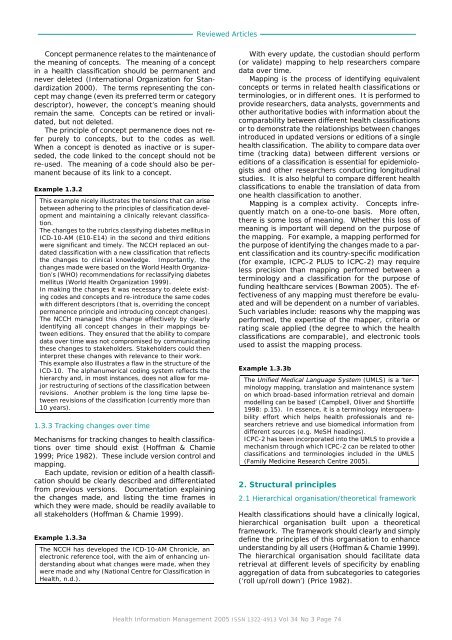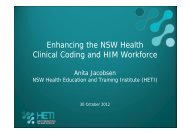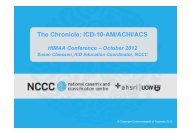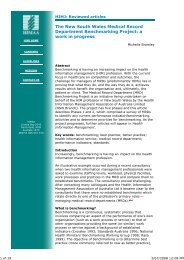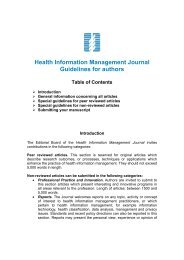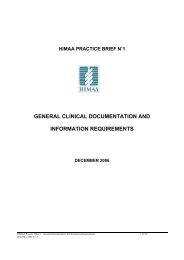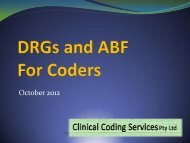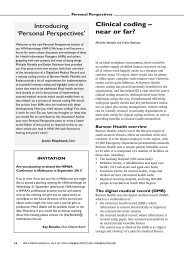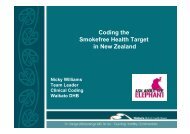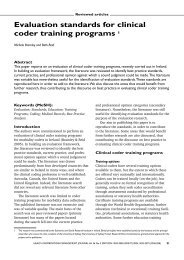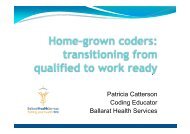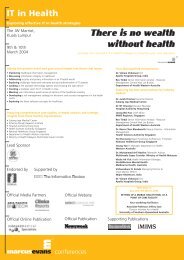A framework for evaluating health classifications - Health Information ...
A framework for evaluating health classifications - Health Information ...
A framework for evaluating health classifications - Health Information ...
You also want an ePaper? Increase the reach of your titles
YUMPU automatically turns print PDFs into web optimized ePapers that Google loves.
Reviewed Articles<br />
Concept permanence relates to the maintenance of<br />
the meaning of concepts. The meaning of a concept<br />
in a <strong>health</strong> classification should be permanent and<br />
never deleted (International Organization <strong>for</strong> Standardization<br />
2000). The terms representing the concept<br />
may change (even its preferred term or category<br />
descriptor), however, the concept’s meaning should<br />
remain the same. Concepts can be retired or invalidated,<br />
but not deleted.<br />
The principle of concept permanence does not refer<br />
purely to concepts, but to the codes as well.<br />
When a concept is denoted as inactive or is superseded,<br />
the code linked to the concept should not be<br />
re-used. The meaning of a code should also be permanent<br />
because of its link to a concept.<br />
Example 1.3.2<br />
This example nicely illustrates the tensions that can arise<br />
between adhering to the principles of classification development<br />
and maintaining a clinically relevant classification.<br />
The changes to the rubrics classifying diabetes mellitus in<br />
ICD-10-AM (E10-E14) in the second and third editions<br />
were significant and timely. The NCCH replaced an outdated<br />
classification with a new classification that reflects<br />
the changes to clinical knowledge. Importantly, the<br />
changes made were based on the World <strong>Health</strong> Organization’s<br />
(WHO) recommendations <strong>for</strong> reclassifying diabetes<br />
mellitus (World <strong>Health</strong> Organization 1999).<br />
In making the changes it was necessary to delete existing<br />
codes and concepts and re-introduce the same codes<br />
with different descriptors (that is, overriding the concept<br />
permanence principle and introducing concept changes).<br />
The NCCH managed this change effectively by clearly<br />
identifying all concept changes in their mappings between<br />
editions. They ensured that the ability to compare<br />
data over time was not compromised by communicating<br />
these changes to stakeholders. Stakeholders could then<br />
interpret these changes with relevance to their work.<br />
This example also illustrates a flaw in the structure of the<br />
ICD-10. The alphanumerical coding system reflects the<br />
hierarchy and, in most instances, does not allow <strong>for</strong> major<br />
restructuring of sections of the classification between<br />
revisions. Another problem is the long time lapse between<br />
revisions of the classification (currently more than<br />
10 years).<br />
1.3.3 Tracking changes over time<br />
Mechanisms <strong>for</strong> tracking changes to <strong>health</strong> <strong>classifications</strong><br />
over time should exist (Hoffman & Chamie<br />
1999; Price 1982). These include version control and<br />
mapping.<br />
Each update, revision or edition of a <strong>health</strong> classification<br />
should be clearly described and differentiated<br />
from previous versions. Documentation explaining<br />
the changes made, and listing the time frames in<br />
which they were made, should be readily available to<br />
all stakeholders (Hoffman & Chamie 1999).<br />
Example 1.3.3a<br />
The NCCH has developed the ICD-10-AM Chronicle, an<br />
electronic reference tool, with the aim of enhancing understanding<br />
about what changes were made, when they<br />
were made and why (National Centre <strong>for</strong> Classification in<br />
<strong>Health</strong>, n.d.).<br />
With every update, the custodian should per<strong>for</strong>m<br />
(or validate) mapping to help researchers compare<br />
data over time.<br />
Mapping is the process of identifying equivalent<br />
concepts or terms in related <strong>health</strong> <strong>classifications</strong> or<br />
terminologies, or in different ones. It is per<strong>for</strong>med to<br />
provide researchers, data analysts, governments and<br />
other authoritative bodies with in<strong>for</strong>mation about the<br />
comparability between different <strong>health</strong> <strong>classifications</strong><br />
or to demonstrate the relationships between changes<br />
introduced in updated versions or editions of a single<br />
<strong>health</strong> classification. The ability to compare data over<br />
time (tracking data) between different versions or<br />
editions of a classification is essential <strong>for</strong> epidemiologists<br />
and other researchers conducting longitudinal<br />
studies. It is also helpful to compare different <strong>health</strong><br />
<strong>classifications</strong> to enable the translation of data from<br />
one <strong>health</strong> classification to another.<br />
Mapping is a complex activity. Concepts infrequently<br />
match on a one-to-one basis. More often,<br />
there is some loss of meaning. Whether this loss of<br />
meaning is important will depend on the purpose of<br />
the mapping. For example, a mapping per<strong>for</strong>med <strong>for</strong><br />
the purpose of identifying the changes made to a parent<br />
classification and its country-specific modification<br />
(<strong>for</strong> example, ICPC-2 PLUS to ICPC-2) may require<br />
less precision than mapping per<strong>for</strong>med between a<br />
terminology and a classification <strong>for</strong> the purpose of<br />
funding <strong>health</strong>care services (Bowman 2005). The effectiveness<br />
of any mapping must there<strong>for</strong>e be evaluated<br />
and will be dependent on a number of variables.<br />
Such variables include: reasons why the mapping was<br />
per<strong>for</strong>med, the expertise of the mapper, criteria or<br />
rating scale applied (the degree to which the <strong>health</strong><br />
<strong>classifications</strong> are comparable), and electronic tools<br />
used to assist the mapping process.<br />
Example 1.3.3b<br />
The Unified Medical Language System (UMLS) is a ‘terminology<br />
mapping, translation and maintenance system<br />
on which broad-based in<strong>for</strong>mation retrieval and domain<br />
modelling can be based’ (Campbell, Oliver and Shortliffe<br />
1998: p.15). In essence, it is a terminology interoperability<br />
ef<strong>for</strong>t which helps <strong>health</strong> professionals and researchers<br />
retrieve and use biomedical in<strong>for</strong>mation from<br />
different sources (e.g. MeSH headings).<br />
ICPC-2 has been incorporated into the UMLS to provide a<br />
mechanism through which ICPC-2 can be related to other<br />
<strong>classifications</strong> and terminologies included in the UMLS<br />
(Family Medicine Research Centre 2005).<br />
2. Structural principles<br />
2.1 Hierarchical organisation/theoretical <strong>framework</strong><br />
<strong>Health</strong> <strong>classifications</strong> should have a clinically logical,<br />
hierarchical organisation built upon a theoretical<br />
<strong>framework</strong>. The <strong>framework</strong> should clearly and simply<br />
define the principles of this organisation to enhance<br />
understanding by all users (Hoffman & Chamie 1999).<br />
The hierarchical organisation should facilitate data<br />
retrieval at different levels of specificity by enabling<br />
aggregation of data from subcategories to categories<br />
(‘roll up/roll down’) (Price 1982).<br />
<strong>Health</strong> In<strong>for</strong>mation Management 2005 ISSN 1322-4913 Vol 34 No 3 Page 74


